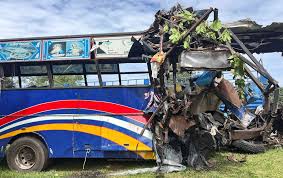KAMPALA, Oct 22 – Authorities in Uganda announced on Wednesday that the death toll from a catastrophic road accident on one of the country’s busiest highways has been revised downward to 46 people. Earlier in the day, the Uganda Police Force (UPF) had reported that 63 people had lost their lives.
The collision took place just after midnight on the major thoroughfare between the capital Kampala and the northern city of Gulu. According to the police, the crash involved two buses, a lorry (truck), and a sport utility vehicle (SUV). The preliminary investigation suggests that both buses were attempting to overtake other vehicles—one a lorry, the other an SUV—from opposite directions, when they collided head-on.
One of the drivers, in trying to avoid the collision, swerved and triggered a chain reaction that caused other vehicles to lose control and overturn. The crash site was at Kitaleba Village near Asili Farm in the Kiryandongo District, according to the police. Emergency services rushed to the scene and transported the injured to the nearby Kiryandongo General Hospital and other medical facilities. The bodies of the deceased were taken to the hospital mortuary for identification and post-mortem examinations.
Shortly after the accident, the Uganda Police Force initially reported that 63 people had died. Later, the figure was revised to 46 fatalities. The reason given by the police: several victims were found unconscious at the crash scene and were mistakenly counted as dead in the early tally. The official amended statement said: “At the time of the crash, several victims were found unconscious, and some may have been mistakenly included in the initial fatality count.” The corrected figure is now considered more accurate as investigations proceed and confirmations are made via hospital records.
This tragic incident highlights the longstanding challenge of road safety in Uganda. The highway linking Kampala and Gulu is one of the country’s major transportation arteries—and one of its most dangerous. It carries large volumes of passenger buses, trucks, and other vehicles. According to police statistics, there has been a worrying rise in road traffic crashes in recent years. For example, in 2024 the number of reported road-traffic crashes increased by roughly 6.4% over the previous year; and fatalities are rising. One of the leading causes: reckless overtaking and dangerous maneuvers. In 2024, the UPF attributed around 44.5% of all documented crashes to careless overtaking.
Based on the initial probe:
- Both buses were travelling on the Kampala–Gulu highway in opposite directions.
- Each bus attempted to overtake another vehicle at nearly the same time—the one from Kampala was overtaking a lorry, and the one from the opposite direction was overtaking an SUV.
- The overtaking manoeuvres brought the two buses onto a collision course. A driver’s swerve to avoid the impact triggered a side collision, overturning vehicles and causing the chain reaction.
- The crash site’s heavy involvement of large vehicles (buses, truck) and the aftermath underscores how rapidly such overtaking errors can become deadly.
In response to the tragedy, the police used their statement to reiterate a warning to all motorists: exercise maximum caution, avoid dangerous overtaking, and follow traffic rules.
The country’s President Yoweri Museveni extended his condolences to the victims’ families. He was campaigning relatively close to the crash location at the time of the incident, underlining how this tragedy has cut across both public safety and the national political discourse. Hospitals and emergency services are now working to identify the deceased, verify the number of injured, and assess the crash’s full human toll. Meanwhile, traffic investigators are focusing on the mechanical integrity of the vehicles, driver behaviour, road conditions, and visibility factors at the time of the crash.
This accident serves as a stark reminder of the vulnerabilities in Uganda’s road transport system:
- Driver behaviour: Risky overtaking remains a frequent cause of serious accidents. Better enforcement of traffic laws is required.
- Vehicle safety: Large passenger buses often travel long distances at night. Ensuring buses are properly maintained and drivers well-rested is vital.
- Road infrastructure: Some of Uganda’s major highways, including the Kampala–Gulu stretch, have sections that are narrow, poorly lit, or suffer from erosion and wear. Improving road design, signage, lighting, and lane separation could reduce accident risk.
- Emergency response: Rapid and efficient rescue and medical response can reduce fatalities after a crash. The fact that unconscious victims were initially mis-counted suggests challenges in on-site accounting and triage.
- Public awareness: Beyond infrastructure and enforcement, there is a need for widespread public education on road safety norms—especially for the drivers of large transport vehicles.
In the early hours of Oct. 22, 2025, the Kampala–Gulu highway became the scene of one of Uganda’s deadliest recent road accidents. Two buses attempting overtaking manoeuvres collided head-on, triggering a catastrophic crash that claimed 46 lives, after an initial count of 63 was revised downward. The circumstances—overtaking, large vehicles in opposite directions, a chain reaction of collisions—are sadly representative of systemic issues in road safety in Uganda.
While investigations are ongoing, the incident underscores urgent needs: stronger enforcement of traffic laws, improved road infrastructure, tighter regulation of bus and heavy-vehicle travel, and heightened public awareness of safe driving practices. As Uganda mourns the victims and supports the injured, the crash also serves as a sobering call to action for better road safety measures across the country.

